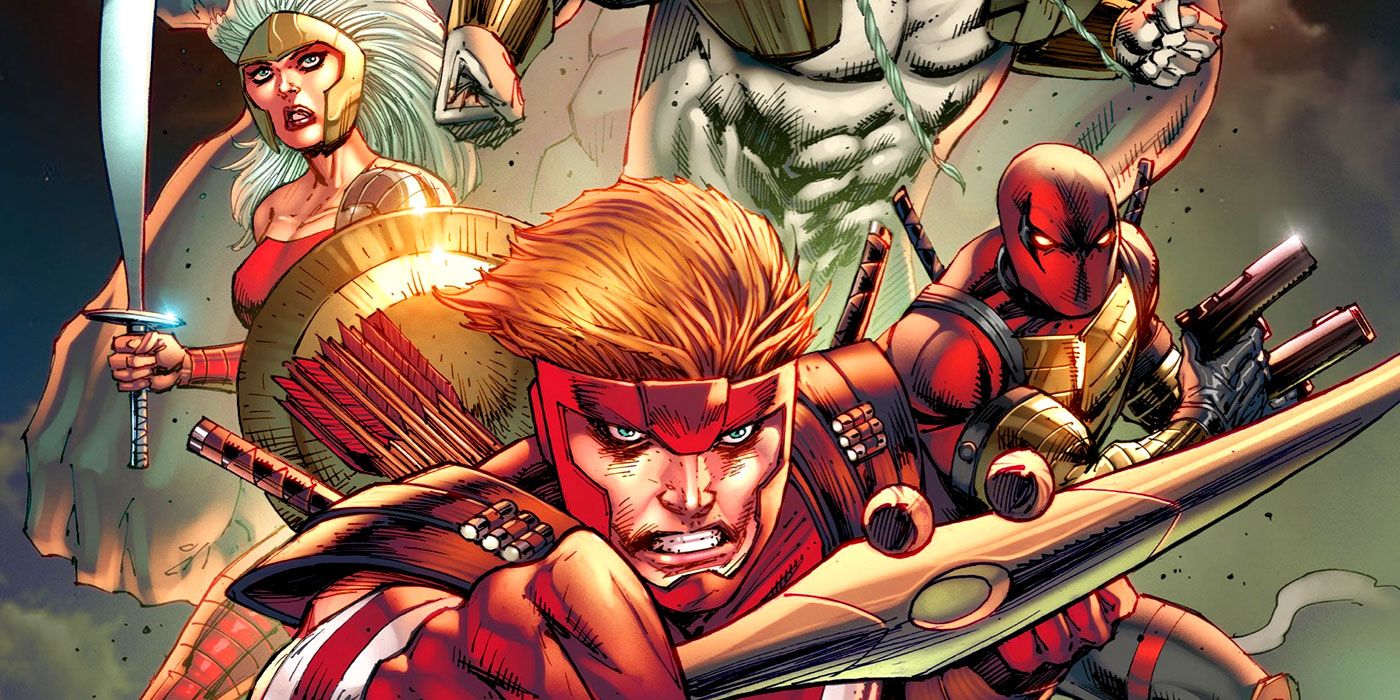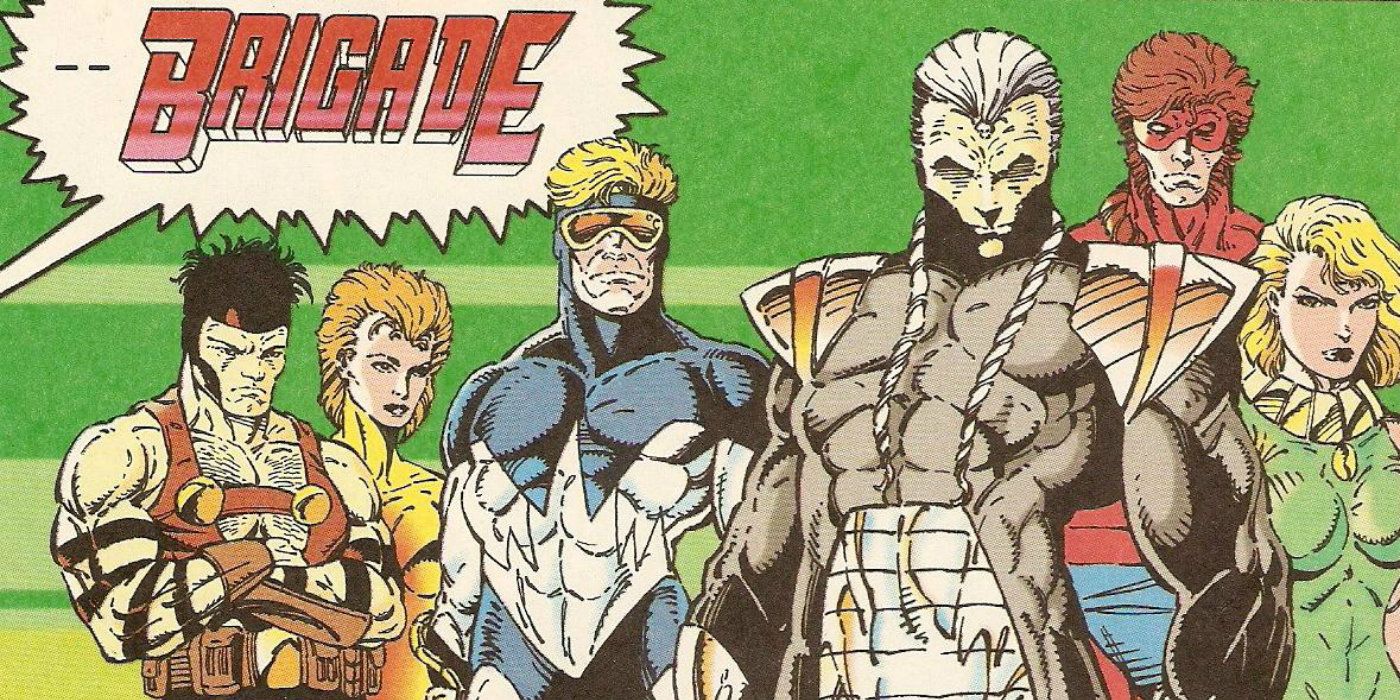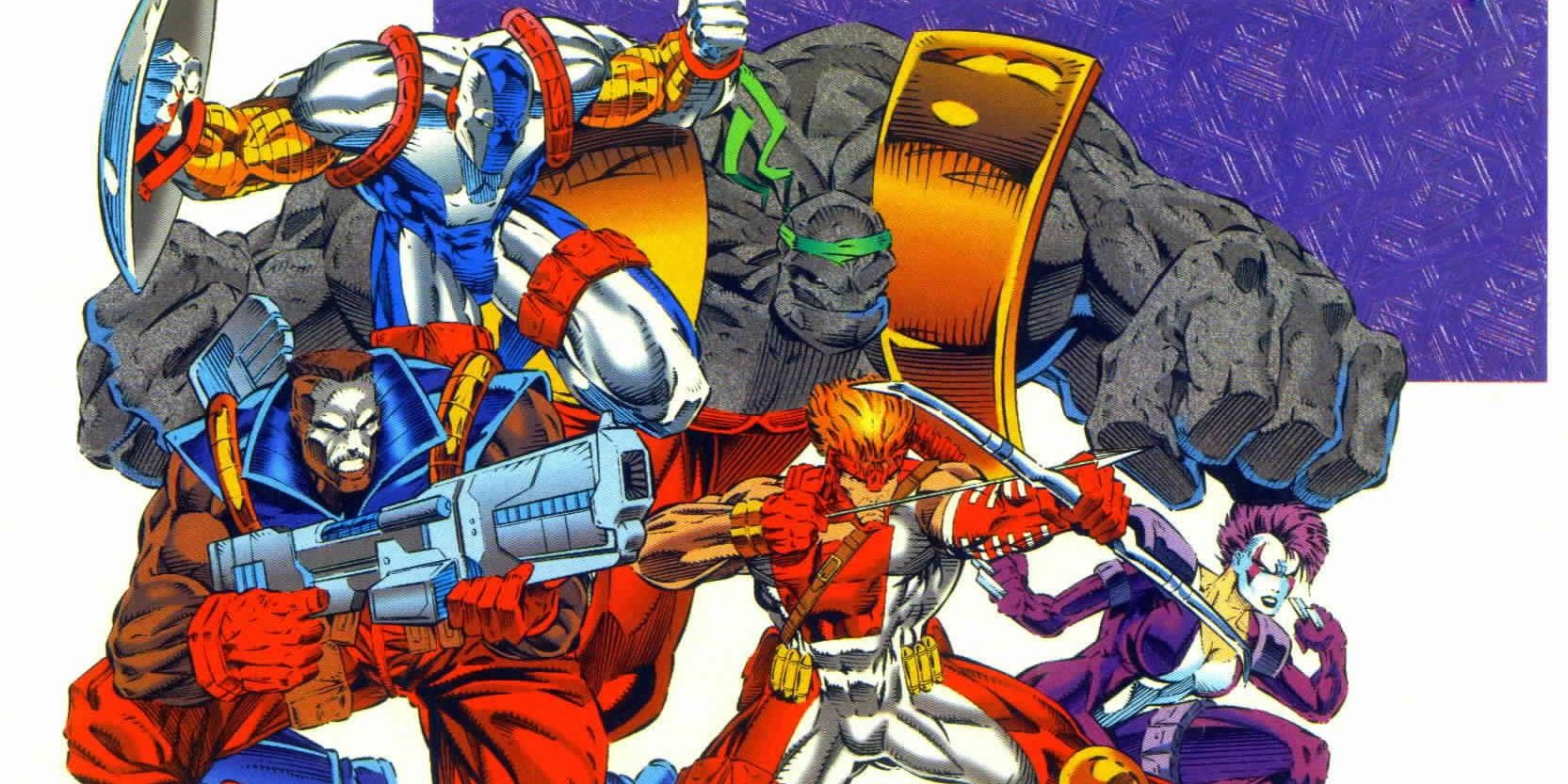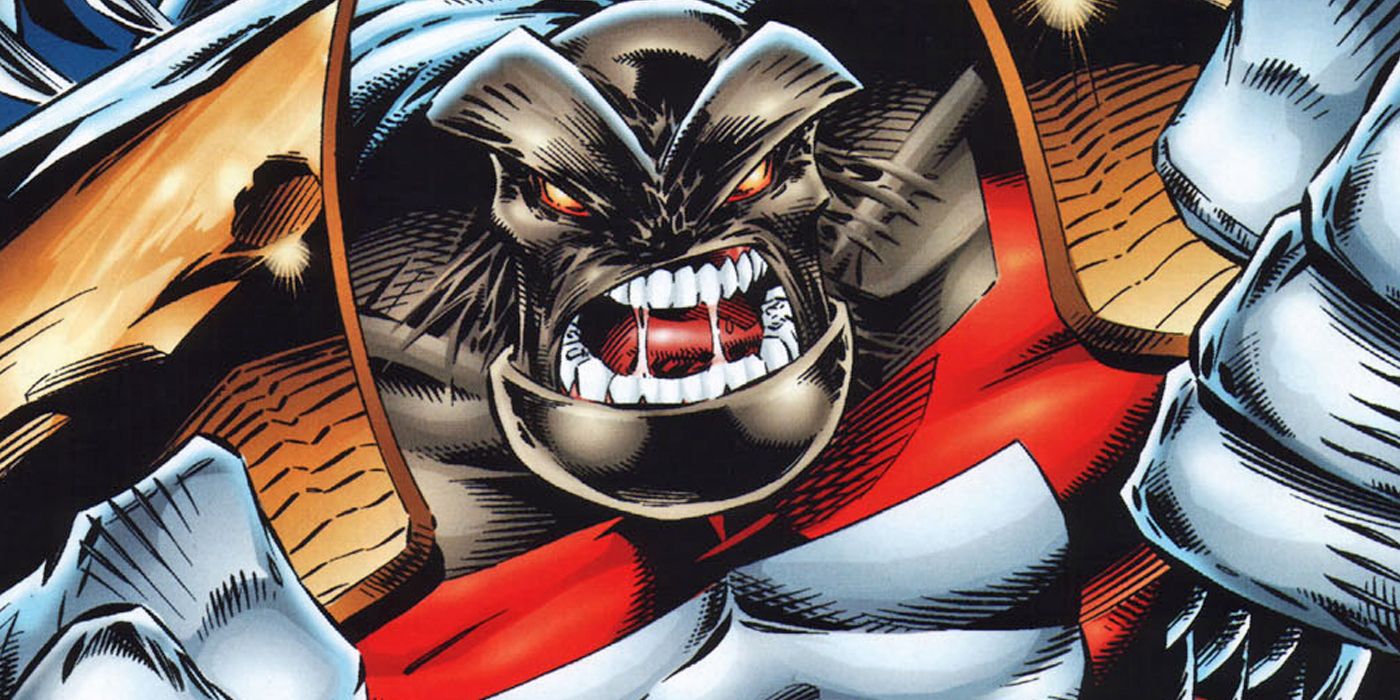As the hour came for the 25 Years of Rob Liefeld Creations, perhaps a hundred people in the audience looked towards an empty stage. A huge crowd of creators came in seven minutes later, struggling to fit on stage. At the podium, Walking Dead creator Robert Kirkman said, "we are pushing the weight limit on this stage to the extreme!" riffing on the name of Liefeld's studio.
The lineup on the stage was a murderer's row of top level comics talent: Marat Mychaels, Dan Fraga, Norm Rapmund, Andy Park, Shannon Eric Denton, Todd Nauck, Dan Panosian, Art Thibert, Jaime Mendoza, Danny Miki and Top Cow editor Matt Hawkins, who went into the crowd to get himself a chair.
Liefeld himself stood next to Kirkman, saying, "We'll be like Captain and Tennille." He related the story of meeting Kirkman in 2003 at a convention in Chicago. Youngblood had just relaunched as a self-published work. Liefeld had just begun reading Invincible. Kirkman introduced himself and Liefeld got very excited. "I started slathering him with all the love he deserves. We spent a wild 48 hours together."
"It was great," Kirkman agreed, "and no one will ever find those bodies."
Kirkman pointed out that Mychaels was Liefeld's assistant at the time.
"Marat knows where the bodies are!" Liefeld joked.
Liefeld said Mychaels was a promising artist when they met at a Los Angeles comic book convention. "This was the dawn of FedEx. Marat and I had some wild trips to FedEx. I was like, 'It's 4:49, we've gotta get there by 5!'"
RELATED: Cable Creator Liefeld Draws Josh Brolin as Deadpool 2’s Co-Star
Kirkman asked if there was any finishing the page while in the car, which Liefeld scoffed at. He said he wanted to build a comics community, and Mychaels drove an hour and a half every day, each way, to Liefeld's Orange County studio. "Without Marat, there is no Dan [Fraga]. I met Norm when his hair was down to his butt and he looked like the lead singer of Striper!"
The crowd laughed at that and Liefeld asked, "Who do you want me to say? KISS? Whatever ..."
"This panel is just to embarrass all of you, one by one," Kirkman said.
"Norm showed me his stuff," Liefeld continued. "Not the strongest artist at the time, but his inking ... you could totally ink. One by one, everyone is connected."
Rapmund brought back Nauck's minicomic and Liefeld flew him to California, setting him up with work and a place to stay. "That's when I was rolling big! There was a house -- they can tell you about the Extreme House."
Liefeld credits the success of the first two issues of Youngblood to the creation of the Bloodlines crossover from DC and New Blood from Marvel. Since nothing else in comics had the word "blood" in the title, Liefeld assumed "they're coming for me. Suddenly, 'blood' is as popular as 'X' in the industry, because of yours truly."
"Blood is the new X!" Kirkman proclaimed. "I think that is the most definitive statement you can make about the '90s."
Liefeld wanted to get all his characters in print before other companies could snatch up names he wanted to use, which meant a hiring spree, starting with Marat on Brigade.
Mychaels said the Extreme House was on a cul de sac next to a fraternity house that got exiled from their campus. "I lived there probably the longest."
"Todd, you lived in the Extreme House?" Kirkman asked.
"I was the last one," Nauck replied.
"You burned that thing down!" Kirkman said. "You were like, 'Todd Nauck OUT!'"
RELATED: Yes, Deadpool Can Regrow His Li’l Wade, Rob Liefeld Assures
"All these bodies, I was like, 'Gasoliiiine ...'" Nauck joked.
"I was like, 'Have you guys cleaned this house in two years?'" Mychaels recalled. "The dishes got so bad, we disbanded the kitchen altogether."
Fraga was asked if he lived in this, and he said, "I was with Rob at first, then I lived on my own, like a smart guy."
Each panelist recalled their introduction to Extreme. Mychaels, for example, was 12 when he met a 16-year-old Liefeld, already working professionally. They became friends a couple of years later.
"Did you get taller than him?" Kirkman asked.
"I did," Mychaels said, "but I still wouldn't fight Rob. He's crazy!"
When Mychaels turned 18, Rob hired him as an assistant and gave the younger man work on "X-Force" less than a year later. The royalty check led Mychaels to tell his mother to never complain about him doing comics again.
"What was the exact dollar amount?" Kirkman asked. "I'm kidding!"
"About what you make in about two minutes," Mychaels returned.
"Now you're making me uncomfortable!" Kirkman replied as the audience laughed.
Fraga said he joined the crew by "Forrest Gumping my way in," using a public access TV show to cold call publicly listed comics creators on air. When he got a convention sketch of Stryfe, Liefeld inadvertently left his phone and fax numbers on the back. Fraga started faxing in samples, which Liefeld initially ignored but Mychaels championed. In 1991 at San Diego, Liefeld apparently told Fraga he was starting a company called McLarFeld with Erik Larsen and Todd McFarlane.
RELATED: Rob Liefeld Reviving Extreme Imprint for Anthology Comic
"Hold on, did you just say 'McLarFeld?'" Kirkman asked, shocked. "I'm an Image trivia aficionado, and I have never..."
"McLarFeld," Fraga reiterated. "I really wanted to be a part of that." DC was showing some interest in his samples, but he fell in with Mychaels. His first day with Extreme was the day Image Comics was announced on CNN, and Fraga was seen eating Chinese food with the founders on television, just six months out of high school.
Liefeld pointed out that the CNN story was shot at Liefeld's studio, where all the Image founders assembled on 24 hours notice to "act like a comics company. Everyone flew home afterwards, and it was just me and Marat, and eventually Dan again."
Rapmund was introduced to Liefeld by a comic store owner who was the only person to ever see Rapmund's samples. Rather than penciling, however, Liefeld hired him to ink. He said he could, despite not knowing how, and got Speedball ink pens. Liefeld came to see Rapmund using these less-than-professional tools and laughed at the neophyte. "Then Rob introduced me to 102 Nib and I'm like, 'oh, that's tiny!' From that point on to 25 years later, that was my inking journey. When I meet someone at a convention who says, 'I don't show anyone my work,' I say, 'show everybody.' If I never showed anyone, I would not be here today."
Kirkman credited Liefeld's ability to spot talent before it became top level.
Andy Park met Liefeld at 1994's Comic-Con International and was hired as an intern, getting into the bullpen half way through college. Liefeld pointed out that Park is now the lead designer on Marvel's films, everything since Captain America: The First Avenger.
Denton drove to California trying to decide between that and Florida, visiting a comic shop as soon as he arrived, without sleeping. They directed him to a convention nearby where he was hired by Marat on the spot.
Nauck's samples led to lots of rejection letters until his friend Jaime Mendoza showed his minicomics to Rapmund, who took them back to Liefeld. Eric Stephenson, then a member of the studio, called Nauck to hire him for some pin ups, which led to more work and the aforementioned moving expense and doing sometimes two pages a day.
Liefeld saw Panosian's work on other comics and recruited him. Thibert was established and became the studio's elder. Mendoza was at Art Institute of Dallas and, after Nauck's success, was offered a job and a place to live if he came to work in Orange County. Miki was Thibert's assistant, which was an easy in. Hawkins, who didn't even read comics, took his nephew to a convention and saw Liefeld hire somebody from the line, asking if he was hiring anyone else, ditching his banking job to write press releases for the company.
"There's no more fun," Liefeld lamented. "I wish I could afford to put the team back together."
The panel ended with a surprise, as Mychaels proposed to his girlfriend of 16 months. Mandy accepted as the panel closed, and cheers were heard all around.




